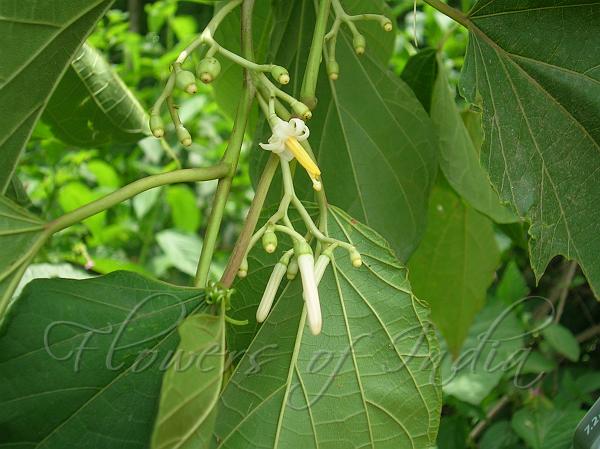|
| Chinese Alangium |
|

|

| File size | 973353 |
| Original date | 5/21/07 12:36 PM |
| Resolution | 2048 x 1536 |
| Flash | Flash did not fire, auto |
| Focal length | 8.0mm |
| Exposure time | 1/203s |
| Aperture | 3.2 |
| Focus Distance | |
| Metering Mode | Partial |
| Camera make | NIKON |
| Camera model | E3700 |
| Sensor type |
|
|
|
|
Photo: |
Botanical name: Alangium chinense Family: Cornaceae (Dogwood family)
Synonyms: Alangium octopetalum, Alangium begoniifolium
Synonyms: Alangium octopetalum, Alangium begoniifolium
Chinese Alangium is a shrub or small tree, 3-5 m tall.
Branchlets are velvet-hairy when young, becoming hairless. Leaf-stalk
is reddish, 4-6 cm; leaf blade ovate or round to heart-shaped, 8-20 x
5-12 cm, below clustered velvet-hairy at axils of veins, above
hairless, strongly 3-5-veined at base, base usually oblique,
occasionally rounded or nearly rounded, or triangular, margin entire or
with few shallow lobes, tip tapering. Flowers are borne in leaf-axils,
in 3-15-flowered cymes. Flowers are about 2 cm. Sepals are 4-7, shortly
toothed. Petals are valvate, 6-8, lanceshaped, 1-1.5 cm. Stamens are
6-8, about as many as petals, hairless. Drupe is ovoid, 5-7 mm, seed 1.
Chinese Alangium is found in the Himalayas, in forests, forest
margins, exposed places, at altitudes up to 2500 m, from Nepal to
Bhutan, Burma, east to China, Malaysia, and also E Africa. Flowering:
May-July, September-October.
| Identification credit: J.M. Garg | Photographed in Imphal, Manipur. |
• Is this flower misidentified? If yes,